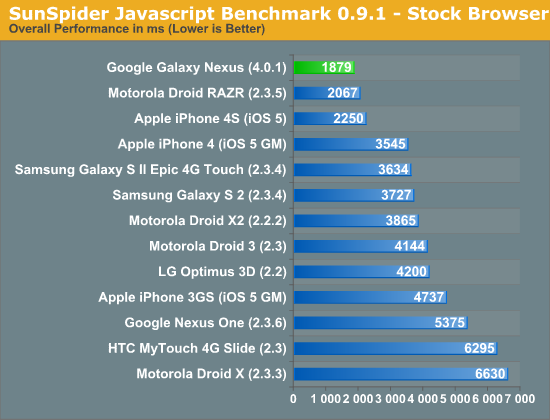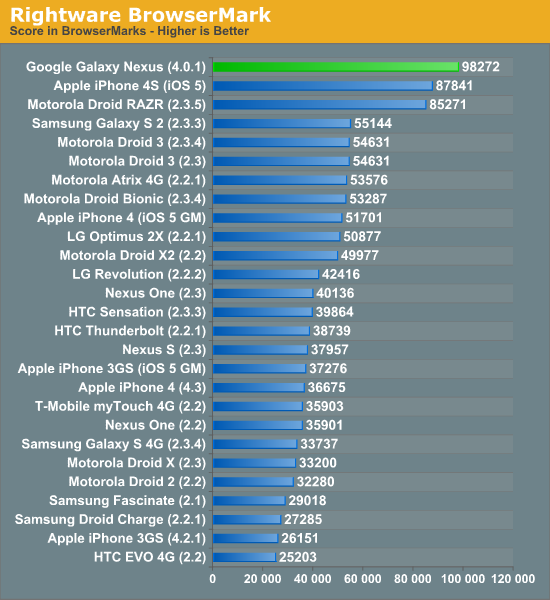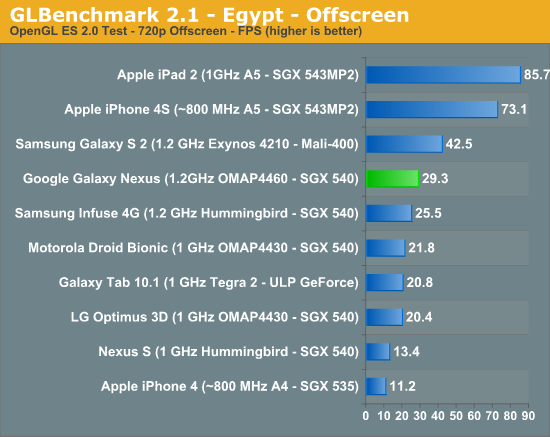Galaxy Nexus & Ice Cream Sandwich: Initial Performance Analysis
by Anand Lal Shimpi on November 18, 2011 11:42 PM ESTThe road to Google's Galaxy Nexus and Android 4.0 (Ice Cream Sandwich) is finally nearing its destination. As of yesterday, the Samsung made Galaxy Nexus went on sale in the UK. Its arrival in the US on Verizon is imminent, but it'll still be another couple of weeks before we can get our hands on a CDMA/LTE sample.
The Galaxy Nexus hardware platform isn't a significant departure from what we've already seen on Android. TI was chosen as the launch silicon partner with its OMAP 4460. The SoC takes a pair of Cortex A9 CPUs running at 1.2GHz and gives them a dual-channel LPDDR2 memory interface to talk to. The GPU is Imagination Technologies' PowerVR SGX 540. The CPU side of things is comparable to Apple's A5, although the cores are clocked noticeably higher than the 800MHz we saw in the iPhone 4S. Until Tegra 3 and Krait show up, the CPU side of the 4460 is as good as it gets.
The real advantage the Galaxy Nexus has is on the software side. All of the goodness of Honeycomb makes its way to a handset along with even further optimization work. One of the early Galaxy Nexus owners ran the usual browser benchmarks on his phone and shared the results with us. Google has obviously done a lot of browser optimization in ICS as performance is now better than even Honeycomb:


The GPU in the Galaxy Nexus isn't bad by any means - the SGX 540 is competent, but it is outgunned by ARM's Mali 400 (Samsung Exynos 4210) and the SGX 543MP2 (Apple A5). As I mentioned earlier, the Galaxy Nexus wasn't about putting the fastest hardware in a phone but rather providing a stable vehicle for Ice Cream Sandwich. Results for the Galaxy Nexus have been in the GLBenchmark database for a while and show an overall improvement over previous SGX 540 implementations (the GPU clock in the 4460 is higher than in the 4430):


Performance is pretty much as expected in both areas: Google really pushed the performance of its software further with Ice Cream Sandwich, while GPU performance is limited by the SGX 540. The good news is that there's more than enough hardware at ICS' disposal to deliver a smooth experience. We'll be able to quantify that once we get our hands on a device.
Source: GLBenchmark, @SigThief










69 Comments
View All Comments
Alexvrb - Sunday, November 27, 2011 - link
Back then PowerVR didn't have the partners or cash to keep pushing forward aggressively enough. They made some nice chips and some key design wins here and there, but they weren't able to beat them in volume or profits.. The last competitive-at-time-of-launch desktop chips they released was Series 3 built by STM (Kyro and Kyro II). I owned one of each at some point, they were quite good for the money at the time.Anyway, I think they're in a much better position these days in the mobile market, than they ever were in the PC/console markets. They have been taking the mobile market by storm ever since MBX. Series 5 (SGX) is doing awesome and Series 6 looks to continue this trend in the near future.
jeremyshaw - Monday, November 21, 2011 - link
You realize Apple's 3.5" display uses a "squat"-er aspect ratio at 960x640, and the actual screen area measured in mm^2 is comparable to a 960x540 ~4" display, right?MamiyaOtaru - Monday, November 21, 2011 - link
his post illustrates *one* of the reasons widescreen monitors are the norm: marketing. A 22" widescreen monitor has significantly less area than a 22" 4:3 monitor. In the same way, he's looking at these "bigger" widescreen handsets, and believing they actually are bigger since they have a larger horizontal value, when actual surface area is about the samekebab77 - Thursday, December 8, 2011 - link
Quad-core A9's may well be slower than dual-core A15's:http://www.bestsmartphone.com/2011/12/08/samsung-w...
Death666Angel - Saturday, November 19, 2011 - link
Yeah, depending on what phone you have, you can really wait.I have an SGS2 (since it was released in May) and am very content with it. I don't think I'll upgrade until late 2012 when 28nm Quad and 720p+ is there. Or I'll keep the phone and get a 7" tablet to go along with it.
ProfessionalGun - Saturday, November 19, 2011 - link
This is the first time I've really been able to see how the Galaxy Nexus's GPU might stack up against those in other top tier phones. Thanks for laying it out in this way - and also for not disparaging the SGX 540 just because it's not the fastest of the bunch. A lot of people act like it's a huge hardware misstep - so it's nice to read that the 540 is a competent GPU.I really cannot wait for this phone to finally become available. I'm frustrated that it seems to be caught-up in Verizon-launch-schedule-politics. (That's my perception, anyway.)
stm1185 - Saturday, November 19, 2011 - link
I think it is a huge hardware misstep, here they have their premier phone for 4.0, one boasting a 720p display and they put in it a GPU that is not even 50% as powerful as the one in the iPhone 4s. They get people want to play games on their phones right.Will the Galaxy Nexus have frame rate problems playing next years new games at its native resolution that the iPhone 4s and the SGS2 phones wont? I am guessing it's likely.
Herp Derpson - Saturday, November 19, 2011 - link
Android has NO GAMES, so it doesn't need best gpu. SGX 540 is competent enoug to accelerate interface, decode video and has pretty decent performance. Also there isn't a single android video player that can use GPU to accelerate videos non-compatible with default player (like MKVs).uwndrd - Saturday, November 19, 2011 - link
There is one video player with HW acceleration - DicePlayer. Go check it out, it has lite version or something.Herp Derpson - Saturday, November 19, 2011 - link
That's pretty awesome, thanks!